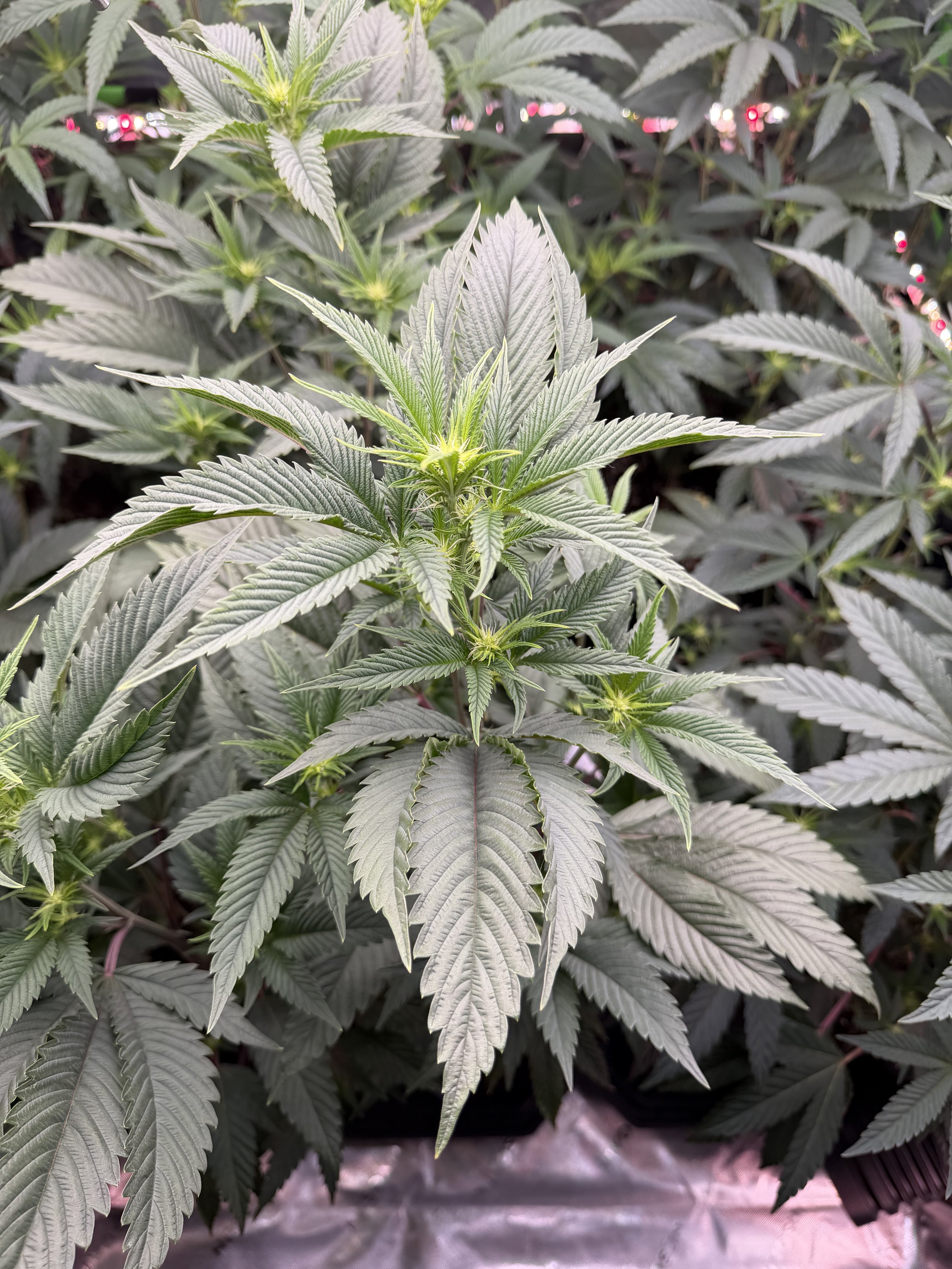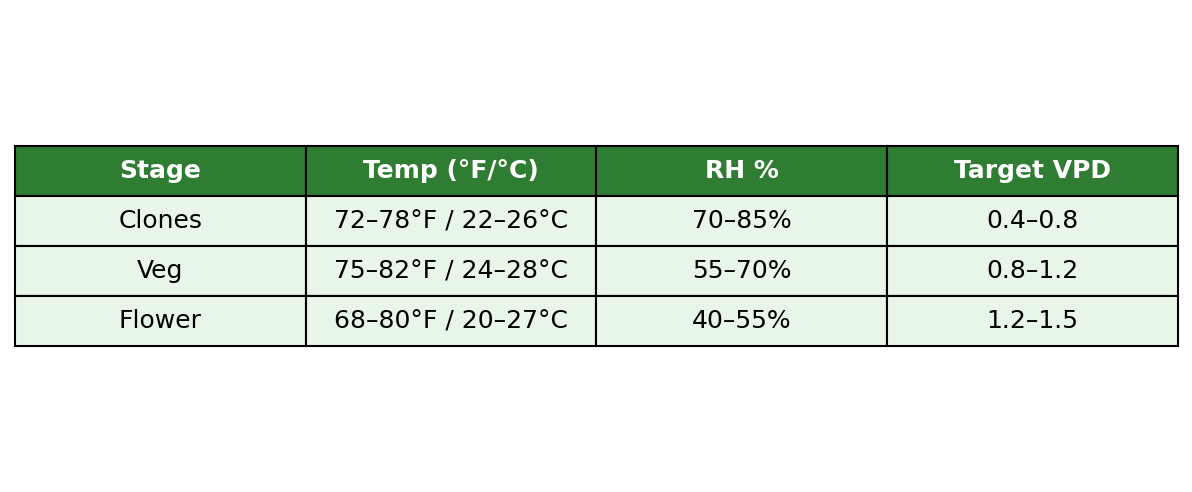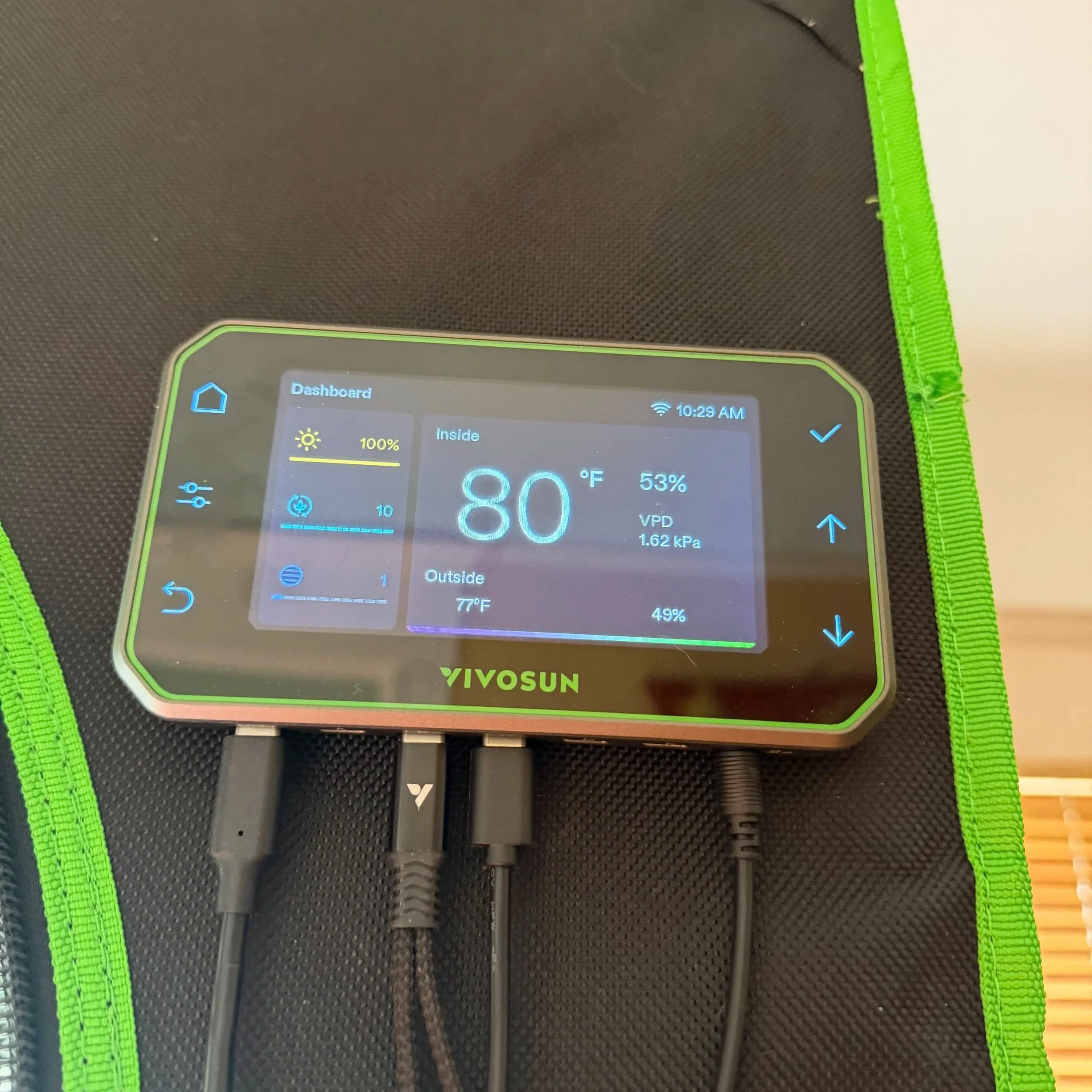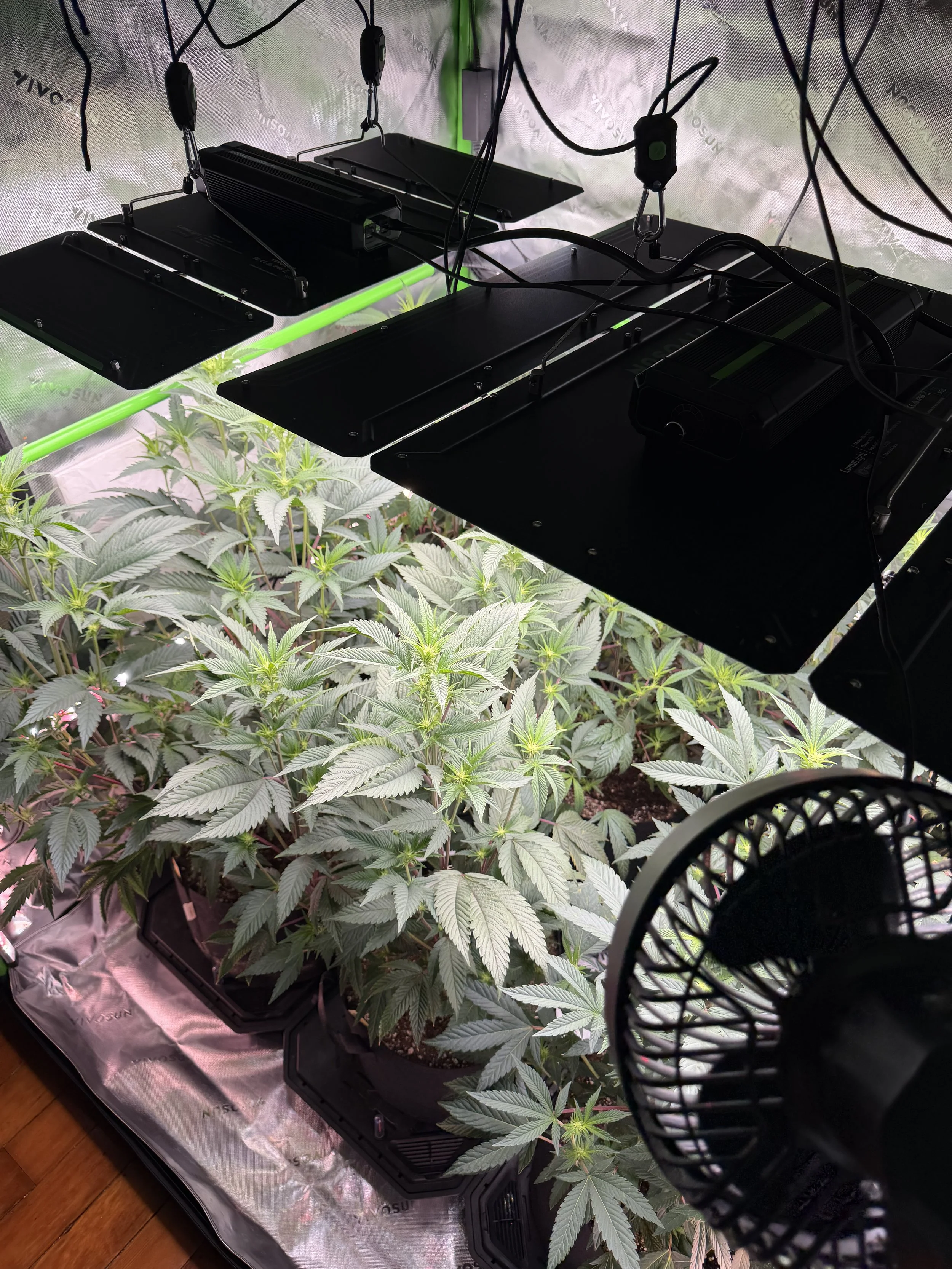Mastering VPD and Climate Control: How We Stabilized Our Indoor Cannabis Tent
Early flowering Ed Rosenthal Super OG from Purple Caper Seeds, showing strong structure, vibrant leaf tone, and stacked bud sites under our stabilized VPD and lighting setup.
A good lighting system gives your plants the energy to grow, but the environment determines how well they can use it. Temperature, humidity, airflow, and VPD all work together to dictate how efficiently your plants drink, breathe, and build new tissue.
Once we upgraded our lighting (400W + 200W + sidebars), the next step was to upgrade the tent’s brain—the environmental controls. This cycle, we replaced our older controller with the VIVOSUN GrowHub E42A+, allowing us to automate temperature, humidity, and airflow with far more precision.
Here’s how VPD works, why it matters, and how a modern controller can turn a good grow into a consistent, predictable one.
What Is VPD? (In Plain Language)
VPD stands for Vapor Pressure Deficit.
It’s a measurement of how strongly your plant is “pulling” moisture from its leaves.
Think of leaves as tiny water pumps:
If the air is too humid, the pump slows down—plants can’t transpire, can’t drink, and nutrients don’t move.
If the air is too dry, the pump runs too fast—plants over-drink, stress, wilt, or show tip burn.
VPD is the sweet spot in between.
When VPD is right, everything becomes easier:
nutrient uptake, photosynthesis, growth speed, and resistance to stress.
Why VPD Matters for Cannabis
When VPD is right, plants show:
Better nutrient uptake
Strong, predictable transpiration
Faster photosynthesis
Stronger structure
Improved resistance to mold and pathogens
When VPD is wrong, you’ll see:
Tip burn
Slow or irregular growth
Powdery mildew
Over-drinking or under-drinking
Calcium deficiency
Wilting and stress
Stable VPD = stable growth.
Recommended VPD Ranges (°F and °C)
A simplified, reliable target chart:
Clones & Seedlings – 0.4–0.8 kPa
(72–78°F / 22–26°C with higher humidity)
Vegetative Growth – 0.8–1.2 kPa
(75–82°F / 24–28°C with moderate humidity)
Flowering – 1.2–1.5 kPa
(68–80°F / 20–27°C with lower humidity)
Lower humidity early helps roots.
Lower humidity late prevents mold.
You don’t have to be perfect—just close.
Leaf Temperature Offset (LTO): The Missing Piece Most Growers Ignore
LEDs run cooler than HPS.
This means leaf temperature is typically 2–5°F lower than the ambient tent temperature.
Since VPD is calculated based on leaf temp, not air temp, adjusting for the offset gives you far more accurate readings.
The E42A+ makes compensation simple and automatic.
The GrowHub E42A+ shows our tent running a touch high on VPD for early flower. To bring VPD into the ideal 1.2–1.5 kPa range, simply lower temperature a couple of degrees or raise humidity slightly. The controller makes these micro-adjustments automatically, keeping the environment stable without constant hands-on tweaking.
A smart controller connects all key equipment, allowing one system to:
Turn devices on or off
Adjust fan speed
Regulate temperature and humidity
Reduce the swings that throw VPD out of balance
Prevent overcorrections that stress plants
The GrowHub E42A+ doesn’t set VPD directly, but it manages the variables that create VPD—temperature, humidity, and airflow. By coordinating these factors, the controller keeps the environment steady without constant hands-on corrections. And because every parameter is adjustable, you can fine-tune your temperature, humidity, and airflow targets with precision.
What Changed with the E42A+
Lights, fans, and humidifiers now work from a single brain
Temperature holds within a much tighter range
Humidity stays consistent, even overnight
Heat from the 400W + 200W lighting setup is corrected automatically
Airflow ramps smoothly depending on canopy conditions
We used to “chase” the environment. Now the environment stays balanced on its own.
Building a Stable Environment Step-by-Step
Here’s how we dialed in the tent after upgrading the controller.
Step 1 — Find Your Baseline
With lights on, measure:
Tent temperature
Tent humidity
Leaf temperature
Leaf temps often run a few degrees lower under LED lighting.
Since VPD is based on leaf temperature, understanding this offset is essential before you make any adjustments.
Step 2 — Choose Your VPD Target Range
You don’t set VPD directly on the controller, but you choose the ranges you want to maintain:
0.9–1.1 in veg
1.2–1.4 in flower
These targets guide your temperature and humidity settings so the controller can keep the environment close to your ideal VPD range.
Step 3 — Let the Controller Do the Heavy Lifting
While the E42A+ doesn’t directly “set” VPD, it stabilizes the conditions that determine it by making continuous micro-adjustments:
Ramping fans up or down to regulate temperature
Activating humidifiers or dehumidifiers as needed
Managing the heat load from your lighting
Maintaining smooth, consistent airflow
You stay in control of your targets— but the controller handles the constant balancing act so you don’t have to micromanage.
Airflow Strategy for a Healthier Canopy
Our airflow system uses two VIVOSUN AeroWave E6 6-inch Clip-On Fans, fully compatible with the GrowHub E42A+. Mounted at canopy height, the E6 circulates air gently across the Ed Rosenthal Super OG plants, preventing hotspots, strengthening stems, and helping the controller maintain stable VPD throughout the tent.
Light and climate are only half the equation. Airflow brings the whole tent together.
Why airflow matters
It pushes CO₂-rich air toward leaves
Prevents condensation
Strengthens stems
Helps manage heat from LEDs
Our airflow setup
Butterfly fans circulating gently
No windburn
No hotspots
Multi-layer air distribution (top, mid, lower canopy)
Exhaust fan ramping smoothly instead of blasting on/off
The tent feels “alive” rather than mechanical.
Common Environment Mistakes and How to Avoid Them
I’ve seen these errors countless times:
Running too much humidity at night
Overventilating (yes, you can!)
Relying on a single hygrometer
Allowing condensation on tent walls
Ignoring leaf temperature
Using an oversized fan that cycles too aggressively
Setting VPD too high for clones or early veg
Good climate control turns a stressful grow into a relaxed, predictable one.
Wrap-Up: Light, Environment & Soil Work Together
Cannabis grows best when three parts are in balance:
Light quality
Environmental stability
Living soil or nutrient system
Now that our tent has:
A refreshed soil base
A new lighting system
A smart climate controller
…the grow has never felt smoother.
Now that the controller keeps the tent steady, the last piece of the puzzle is handling heat, cold nights, and dry cycles with precision. Part 4 breaks down how the AeroLush 4-in-1 completes the system.
What’s Next in This Series
With the environment stabilized, the final step is upgrading climate control itself.
Up next:
👉 Part 4 — Full Climate Automation: Cooling, Heating, Drying & Airflow With a 4-in-1 System
(How we integrated a modern multifunction climate unit into the tent and created a fully automated grow environment.)
If you’re planning to automate or stabilize your grow, this is a great moment to upgrade your gear. VIVOSUN is running strong seasonal deals on controllers, lights, and tent accessories.
Use my code Ed420 for additional savings on select items.
A smart controller is one of the most important upgrades you can make in an indoor cannabis garden.




